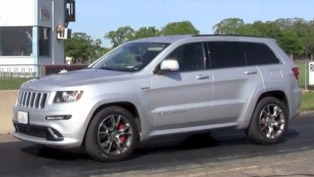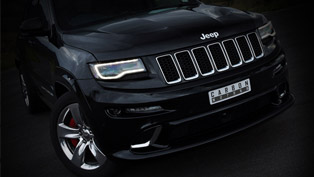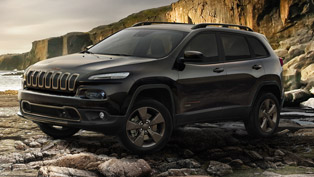2012 Jeep Grand Cherokee SRT8
Jeep has introduced the new 2012 Grand Cherokee SRT8 at the 2011 New York Auto Show (NAIAS). It is the most powerful SUV, which the manufacturer has ever made.
The power comes from a enormous 6.4 liter HEMI V8 with 465HP (342 kW) and 630Nm (465 lb-ft), which is available from just 2800RPM and up to 6000RPM. 0 to 100 km/h is reached in 4.8 seconds and the top speed is limited to 250 km/h (155 mph). With such performance, the big SUV is a real rival to the mighty BMW X5M, ML63 AMG and Cayenne Turbo.
2012 Cherokee SRT8 is able to pull up to 0.9 G on the skid pad, so it is not fast only in straight line, but the big SUV is able to turn very well. The reason is a new adaptive damping suspension managed by new Selec-Track system.
The new Cherokee SRT8 offers paddle shifters on the steering wheel, better interior quality and brutal exterior. It also comes with a mind-blowing 19-speaker premium Harman Kardon audio surround-sound system with total power of 825 Watts and a 10" subwoofer.
2012 Jeep Grand Cherokee SRT8 is scheduled to hit the market in the third quarter 2011. Price list is not announced, yet.
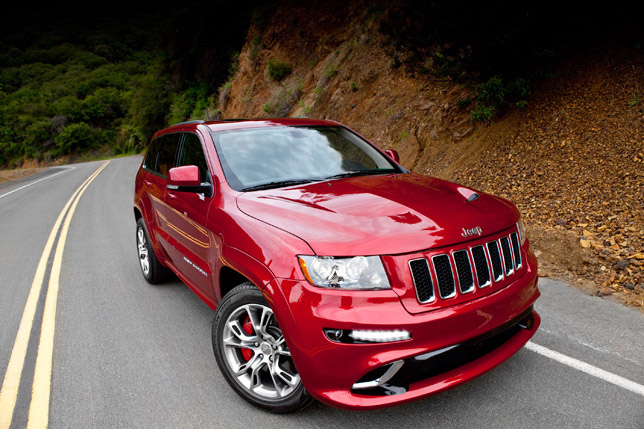
Safety and security:
- Active head restraints: Deploy in the event of a rear collision. Restraints are designed to reduce injuries by minimizing the gap between the head restraint and the passenger's head
- Active turn signals: Turn signal flashes three times when stalk is depressed for one second to indicate a lane change
- Adaptive cruise control (ACC): The system decreases the vehicle's pre-set cruise-control speed when closing in on another vehicle in the same lane, or when another vehicle pulls into the same lane. The system will accelerate to the pre-set speed when the vehicle in front speeds up or moves into another lane. ACC will maintain a driver adjustable distance between the vehicle and the one in front of it, allowing the use of cruise control in light traffic without having to continuously adjust settings
- Advanced multi-stage air bags: Inflates with a force appropriate to the severity of the impact Meets FMVSS 208 advanced air bag requirements for smaller, out-of-position occupants
- Anti-lock brake system (ABS): Senses and prevents wheel lockup, offering improved steering control under extreme braking and/or slippery conditions
- Anti-lock brake system with rough-road detection: Anti-lock brake system capable of detecting if the vehicle is driving on a rough road by the oscillations in the wheel speed signals. When rough road is detected on off-road surfaces or trails, ABS enters a different pressure control where it will hold the brake pressure for longer pulses
- BeltAlert: Activates a chime and/or illuminates an icon in the instrument cluster to remind the driver and front passenger to buckle up if a vehicle is driven without belted front-seat occupants
- Blind-spot Monitoring (BSM): Uses dual ultra-wideband radar sensors to aid the driver when changing lanes, or if being passed by or passing unseen vehicles. The system notifies the driver of vehicle(s) in their blind spot via illuminated icons on the sideview mirror and with a driver-selected audible chime
- Brake Assist: In an emergency brake situation, the system applies maximum braking power, minimizing the stopping distance
- Brake Override: When a disagreement exists between the throttle and the brake, the brake signal causes the engine controller to reduce engine power, allowing the operator to stop the car
- Brake-traction control system (BTCS): Helps to keep driving wheels from spinning during acceleration from a stop or during slow speeds by applying individual brakes to the slipping wheel(s)
- Child seat anchor system: LATCH (Lower Anchors and Tethers for CHildren) is designed to ease installation of compatible aftermarket child seats
- Constant-force Retractors (CFR): Regulates the force exerted on the occupant by the seat belt, and then gradually releases seat-belt webbing in a controlled manner
- Electronic roll mitigation (ERM): An extension of electronic stability control (ESC). Uses input from ESC sensors to anticipate if the vehicle is at risk of entering a potential roll situation, then applies the brakes individually and modulates the throttle position as needed
- Electronic stability control (ESC): Enhances driver control and helps maintain directional stability under all conditions. Provides the benefit in critical driving situations such as turns, and is valuable when driving on mixed surface conditions including snow, ice or gravel. If there is a discernible difference between driver input through the steering wheel and the vehicle's path, ESC applies selective braking and throttle input to guide the vehicle back on to the driver's intended path
- Energy-absorbing steering column: The power-adjust steering column employs a calibrated bending element that deforms during column stroke for optimal energy management
- Enhanced Accident Response System (EARS): Makes it easier for emergency personnel to see and reach occupants in the event of an accident by turning on the interior lighting and unlocking doors after air bag deployment. Also shuts off flow of fuel to the engine
- Express Up/Down Windows: One-touch powered express up/down window button located on the front driver and passenger-side door
- Forward Collision Warning (FCW): Using forward-facing radar sensors, this system detects when the vehicle may be approaching another vehicle too rapidly and alerts the driver so the driver can determine what action must be taken in order to prevent the vehicle from a collision
- High-intensity discharge (HID) headlamps: Provide approximately three times the light output of conventional reflector lamps for improved nighttime illumination
- Hill-start Assist (HSA): Assists drivers when starting a vehicle from a stop on a hill by maintaining the level of brake pressure applied for a short period of time after a driver's foot is removed from the brake pedal. If throttle is not applied within a short period of time after the driver's foot is removed from the brake pedal, brake pressure will be released
- Keyless Enter-N-Go: When an individual enters the vehicle, electronic sensors detect if the vehicle key fob is present. The vehicle will then allow the individual to push a button to start the vehicle without having to insert the key into the ignition
- Knee bolsters: The lower instrument panel and the glove-box door are designed to properly position the occupant during impact, enabling air bags to work effectively
- Navigation system: Voice-activated navigation system available with real-time traffic to provide precise guidance to destination through the use of global positioning system (GPS) satellite technology
- ParkSense® rear park assist system: Assists at low speeds in reverse to detect stationary objects. Consists of audible warnings for the driver and has a display in the Electronic Vehicle Information Center (EVIC) integrated into the instrument cluster
- ParkView® rear back-up camera: Provides a wide-angle view of the area immediately behind the vehicle, giving the driver greater peace of mind before reversing at low speeds. Contains grid line to aid the driver when maneuvering into parking spaces or narrow areas. Also aids in lining up a trailer to the vehicle's trailer hitch, when so equipped. The image is displayed on the navigation screen when the transmission is shifted into Reverse
- Power tilt-and-telescoping steering column with memory: Allows steering column to tilt and move toward or away from the driver to achieve a safe and comfortable distance from the advanced multi-stage front driver air bag, if deployed
- Rain Brake Support: Uses the ESC pump to occasionally push brake pads lightly against brake rotors in rainy conditions in order to keep rotors dry
- Rain-sensing wipers: A driver convenience feature that automatically senses moisture on the windshield and activates wipers
- Ready Alert Braking: Anticipates situations when the driver may initiate an emergency brake stop and uses the ESC pump to set brake pads against rotors in order to decrease the time required for full brake application
- Rear Cross Path (RCP): In parking lot situations, this system warns drivers backing out of parking spaces of traffic moving toward their vehicle. It activates any time the vehicle is in Reverse. The driver is notified of vehicle(s) crossing behind the vehicle via illuminated icons on the sideview mirror and with a driver-selected audible chime
- Remote (fob) operated windows (front windows - down only): Enable an individual to cool down the vehicle passively by opening front windows remotely
- Remote keyless entry: Locks and unlocks doors and turns on interior lamps. If the vehicle is equipped with a security alarm, the remote also arms and disarms that system
- Remote start: Conveniently starts the engine and activates key comfort settings based on ambient conditions by using the key fob while maintaining vehicle security
- Rollover crash sensing: Senses a rollover and deploys seat belt pretensioners and/or standard full-length side-curtain air bags as needed
- Seat belt pretensioners: During a collision, impact sensors initiate front seat belt pretensioners to remove slack in the seat belt system, thereby reducing the forward movement of the occupant's head and torso
- Sentry Key® engine Immobilizer: Utilizes an engine key that has an embedded transponder with a preprogrammed security code to discourage vehicle theft. When the key is inserted into the ignition, the controller sends a random number to the transponder and the engine is allowed to start. If an incorrect key is used, the engine will shut off after a few seconds
- Signal mirrors: Signal lamp built into the housing of exterior mirrors allows turn signals to be viewed from the front, as well as the sides and rear of the vehicle in order to alert oncoming traffic and pedestrians
- SmartBeam® headlamps: Headlamp system adjusts to ambient light and oncoming traffic to deliver maximum lighting
- Standard full-length side-curtain air bags: Extend protection to all outboard front- and rear-seat passengers. Each side air bag has its own impact sensor that autonomously triggers the air bag on the side where an impact occurs. This type of air bag is housed in the headliner just above side windows
- Standard seat-mounted side thorax air bags: Provide enhanced protection to thedriver and front outboard passenger in certain impacts. Each side air bag has its own impact sensor that autonomously triggers the air bag on the side where an impact occurs. Standard side air bags are housed within the outboard side of each front seat
- Three-point seat belts: Front outboard seating positions and all rear seating positions have lap and shoulder belts
- Tire-pressure monitoring (TPM): Informs driver when tire pressure is too low. Pressure-sensor modules within the valve stems of all four road wheels send continuous radio-frequency signals to a receiver and the system
- Trailer-sway control (TSC): Reduces trailer sway and improves handling in adverse towing conditions caused by crosswinds and traffic. The system monitors the vehicle's movement relative to the driver's intended path, then applies alternating brake pressure to slow the vehicle and then increases the pressure on one front wheel in order to counteract the sway induced by the trailer
- Uconnect® Phone: In-vehicle, voice-activated communication system that allows customers to talk on their Bluetooth compatible phone with your hands on the wheel and eyes on the road. The built-in phonebook sync feature automatically downloads as many as 1,000 phone book entries from supported phones, which can then be selected by simply saying contact name
Source: Jeep
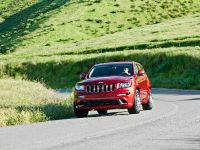
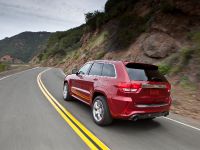
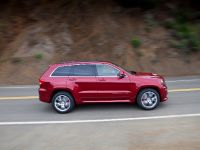
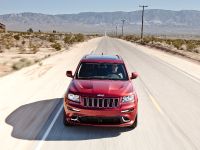
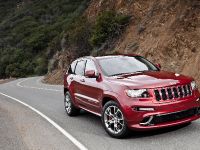
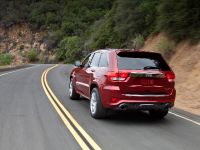
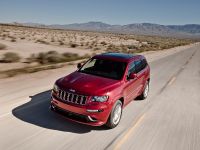
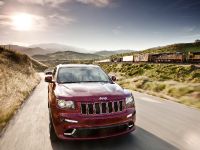
![2012 Jeep Grand Cherokee SRT8 - Lap around Nurburgring 8:49 [video]](http://www.automobilesreview.com/uploads/2012/04/2012-jeep-grand-cherokee-srt8-big.jpg)
